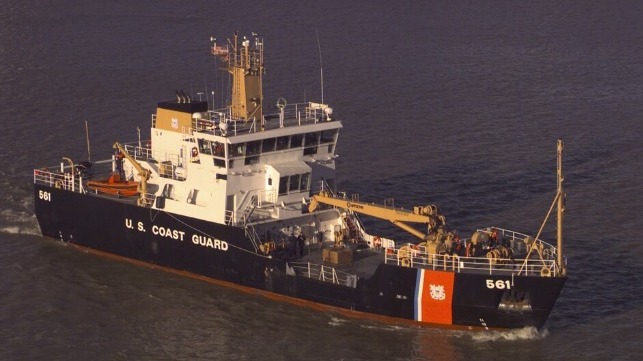Video: OSV Strikes a Working Coast Guard Buoy Tender Twice

A newly-released video shows a collision between an OSV and a U.S. Coast Guard buoy tender in Sabine Pass, shortly after the passage of Hurricane Delta in 2020. Though the casualty happened 15 months ago, it appears to be the first time that the video and accompanying documentation have been published.
On October 11, 2020, two days after Delta made landfall in Louisiana, the U.S. Coast Guard buoy tender Harry Claiborne transited from Galveston to Sabine Pass, where her crew set to the task of checking and resetting buoys along the channel. At about 1525 hours, Claiborne was working on Buoy 27 near the channel entrance, and she was in DP stationkeeping mode with the bow facing outbound. Her crew had the buoy up on deck, and they were hauling in on its chain to determine the location of its sinker, as it had been reported off-station.
The OSV Botruc 33 was outbound in the channel, headed to service an offshore platform. Her captain was at the helm and he contacted Harry Claiborne over VHF to make passing arrangements, proposing to overtake on Claiborne's starboard side. Given the Claiborne's location - on the buoy - this would put Botruc 33 on the outside of the shipping channel, nearer to the bank.
Claiborne's commanding officer answered the call and, after consulting with his bridge team, he agreed to Botruc 33's proposed passing arrangement.
"I notified my bridge crew that we were going to be - that the vessel was going to be overtaking us on our starboard side. The bridge crew did question my decision to let them overtake us on the starboard side, but given that I had seen multiple vessels operating outside the channel throughout the day, I allowed that overtaking on the starboard side," he said in an after-accident interview.
Shortly after this radio communication, a crewmember on deck called up to the bridge on UHF to warn that a collision was imminent. The CO warned the crew to brace for impact and began to sound five short in warning. Within seconds, Botruc 33 struck Harry Claiborne's stern.
A damage assessment revealed a 12 inch hole about eight feet above the waterline, with "severe denting and buckling to the transom," the CO said in an after-action report. No flooding was reported, the propulsion system was functioning, and the DP system automatically returned the vessel to her position as before. As a precaution, the CO ordered the crew to let go the port anchor and secure the deck load. In keeping with Coast Guard damage control standards, her DC team quickly plugged the hole and shored it up with steel.
Meanwhile, Botruc 33 had run aground at the edge of the channel, about 40 yards off the Claiborne's starboard side. Over VHF, the CO heard Botruc 33's captain telling the VTS operator that he was attempting to refloat his vessel. After pumping off ballast, Botruc 33 floated off, then drifted back towards Harry Claiborne on a collision course. The Claiborne's CO ordered fenders deployed on the starboard quarter in order to reduce damage, and shortly after, the Botruc 33 struck again, putting another small dent in the buoy tender's hull.
After the Botruc 33 was clear and past, the Claiborne finished resetting Buoy 27 and departed station. Once under way, her engineers reported a severe knocking sound from the port azipod. The bridge team secured the port engine and headed back to port for repairs.
After the casualty, the captain of Botruc 33 told National Transportation Safety Board investigators that he believed that the stern of his vessel had begun to go aground, causing loss of control. He said that in his experience, there was ordinarily plenty of water depth around Buoy 27, and he believed that the crew of Harry Claiborne should have told him to pass on the other side.
"I thought they were moving the buoy, because when I asked him for one whistle [starboard side overtaking arrangement], he agreed, and then I asked him another time, he agreed. So I just assumed he knew what the depth of the water was, and that's where I was good to pass there," said Capt. Richard Lege, the master of Botruc 33. "Being the buoys was moved and everything and he's working on the buoys, the way he was set up, I was like, okay, let me see, you know. And I never was advised that the water - the depth was shallow or maybe you want to come around on the other side, you know."
